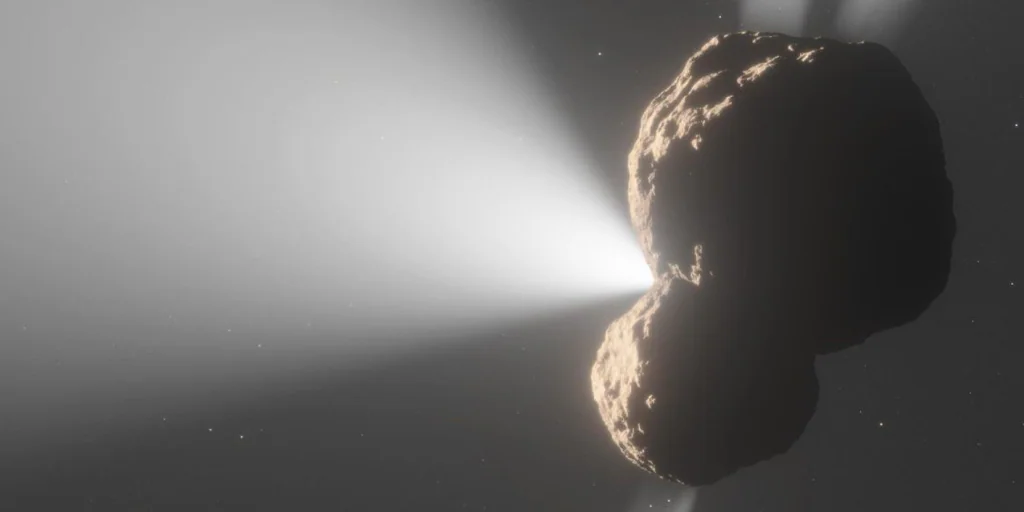Mysterious jets of gas observed in a fast-moving object in the outer solar system

Halfway between the asteroids and comets, the centaurs, space rocks that take their name from the famous half-man, half-horse mythological creatures, have left their distant orbits beyond Neptune to migrate to the inner solar system, towards which they are moving at full speed. . And the closer they are to the Sun, the more they resemble comets and the less they resemble ordinary asteroids.
Remaining for billions of years within the icy confines of our planetary system, centaurs treasure valuable records of their birth, information that is revealed as they slowly begin to melt into this transitory phase of their existence.
Now, an international team of astronomers has used the capabilities of the James Webb Space Telescope to observe 29P/Schwassmann-Wachmann 1, one of the most active and interesting objects in the outer solar system. The high degree of detail obtained by the telescope has allowed the discovery of new, previously unknown gas jets, which helps complete theories about how both the centaurs themselves and the planets formed.
Regular bursts
Thus, centaurs are ancient trans-Neptunian objects that now lie between the orbits of Neptune and Jupiter due to the subtle gravitational influence of the planets over the last few million years.
Because these small icy bodies are in the orbital transition phase, they are of greatest interest, and scientists are trying to understand their composition and what causes their degassing (loss of ice found below the surface). Their unique combination of characteristics actually makes centaurs true hybrids of the primordial icy bodies of the outer solar system and evolved comets that have already passed close to the Sun one or more times.
29P/Schwassmann-Wachmann 1 (abbreviated 29P) is an object known for its highly active quasi-periodic flares. Its intensity changes every six to eight weeks, making it one of the most active objects in the outer solar system. But now, astronomers, thanks to the NIRSpec (Near Infrared Spectrograph) instrument on the James Webb Space Telescope, have just discovered a new carbon monoxide plume and several other carbon dioxide plumes that have never been observed before and that provide new clues about outer space. the nature of the centaur core.
“Centaurs,” explains Sarah Faggi of NASA Goddard Space Flight Center in Greenbelt and lead author of the study published in the journal Nature Astronomy, “can be seen as remnants of the formation of our planetary system. Because they were stored at very low temperatures, they preserve information about volatile elements from the early stages of the solar system’s development. The James Webb Telescope really opened the door to resolution and sensitivity that impressed us: when we first saw the data, we were thrilled. We’ve never seen anything like it.”
difficult to watch
The enormous distance at which the centaurs are located greatly limited the observations of astronomers. And in the case of 29P, the data so far has shown a single jet directed toward the Sun (and Earth), consisting of carbon monoxide (CO). James Webb also discovered this jet, but thanks to his exceptional infrared capabilities, he also discovered many other chemicals such as water (H2O) and carbon dioxide (CO2), one of the main ways carbon is stored worldwide. . Solar system.
The images and data captured by the telescope actually revealed features that had never been observed before: two CO2 jets emanating in the north and south directions, respectively, and a third CO2 jet pointing north. This was the first definitive detection of carbon dioxide in 29P.
Using data collected by Webb, the team created a 3D model of the planes to understand their orientation and origin. And they found that they were emanating from different areas of the centaur’s core, although Webb couldn’t resolve the core itself. The angles of the jets suggest that the core is a collection of individual objects of varying composition; however, other scenarios cannot be ruled out at this time.
The mystery continues
However, the reasons for the sudden increase in 29P’s brightness and the mechanisms by which gas is released through these jets remain a mystery.
When it comes to comets, scientists know that their jets are often powered by the release of gas. However, due to their location, centaurs are too cold for water ice to rise (from a solid to a gas without passing through a liquid phase), meaning that their outgassing patterns are not the same as those of comets.
“We only had time to look at this object once, as a snapshot in time,” explains Adam McKay, co-author of the study. I would like to observe Centauro 29P for a much longer period of time. Do the jets always have the same orientation? Perhaps there is another jet that “turns on” at a different point in its rotation period? “Observing these jets over time would give us a much better idea of what is driving these bursts.”
The researchers hope that by continuing to learn from 29P, they can apply the same techniques to other centaurs. Improving what is known about these objects can simultaneously improve our understanding of the formation and evolution of our solar system.